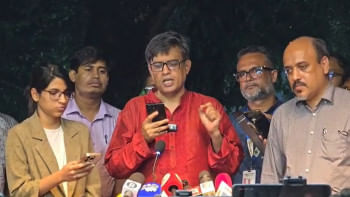Shutki popular food in Ctg, earns foreign currency
The smiling young housewife in an advertisement on TV screen perfectly introduces the Chittagong people and one of their traditional and popular food items as she says, 'Chatgainyara Shutki Khaitey Pochhanda Korey' (Chittagonians love to eat dry fish).
'Shutki' (dry fish) is a popular food item of Chittagong people. It also has a wide popularity throughout the world and Chittagong is now well known for its splendid dry fish exported to far eastern and south eastern countries bringing foreign exchange for the country.
The people who visit Chittagong, never forget to take dry fish with them when return home. At the same time those staying at home request the frequenters to bring some dry fish of Chittagong for them.
Thousands of people of coastal areas of this region are involved in making dry fish as well as salted and dehydrated fish for their livelihood. Though most of the fish the fishermen catch are sold as raw, yet a huge quantity of it is made shutki. After meeting the internal demand it is exported.
The shutki makers and sellers said it has a higher demand in China, Hong Kong, Japan, Singapore, United Kingdom and the Maldives and around Tk. 200 crore could be earned exporting Shutki.
The shutki is being produced here for decades. The fishermen of this region started producing it as part of process preserving the huge surplus of fish they caught in a most natural way. They went to the vast sea in small local boats and went on fishing for months. During this long stay, they gathered their catches on different islands and shores. They dried the huge surplus of fish of different species spreading them in the hot sun on the beaches or even on the boats. Thus the shutki was made to be sold later.
In course of time this traditional process of preserving the surplus fish started to take shape of a small industry. The people living in the vast coastal areas of Cox's Bazar and Chittagong are mostly involved in making shutki.
In Cox's Bazar (known as the fish reservoir of the country) the coastal areas of Luniachhata, Khurulkul, Moheshkhali, Kutubdia, Sonadia, Teknaf, Shahparir Dwip, Saint Martin, Nazirartek, Dhalghata, Ghati Bhanga, Baroghope, Utter Dhurang and Baharchhara are renowned for shutkiproduction.
The shutki is also produced in a great quantity at different coastal areas of Anwara, Patiya and Banshkhali upazila in Chittagong.
The persons involved in making shutki are locally known as 'Bahodders'. With the onset of the dry season the shore areas of the said areas start buzzing with busy activities of Bahodders, workers and other small businessmen. The shutki making starts in early September continue till the beginning of the season next year.
The Bahodders deploy fishermen to catch fish in the sea. Different species of fish like Laukxmya, Rupchanda, Hilsha, Laitya, Popa, Chhuri, Hangor, Chapa, Kamila, Maitya and Koral are caught for making shutki.
Workers dry fish spreading them on Chatai (mats) or hanging from bamboo poles erected on open space.
A large number of women are also involved in shutki production. But they are poorly paid.
The field of both production and business of dry fish has expanded and developed a lot by now. Once catching fish was a tough job when the fishermen had to stay on the sea for days, but now a days they set nets with polls in the sea in the morning and return home with a huge catch in the evening.
But with the expansion of the shutki industry, it has also developed some bad impacts and adversities poising health hazards.

 For all latest news, follow The Daily Star's Google News channel.
For all latest news, follow The Daily Star's Google News channel. 



Comments